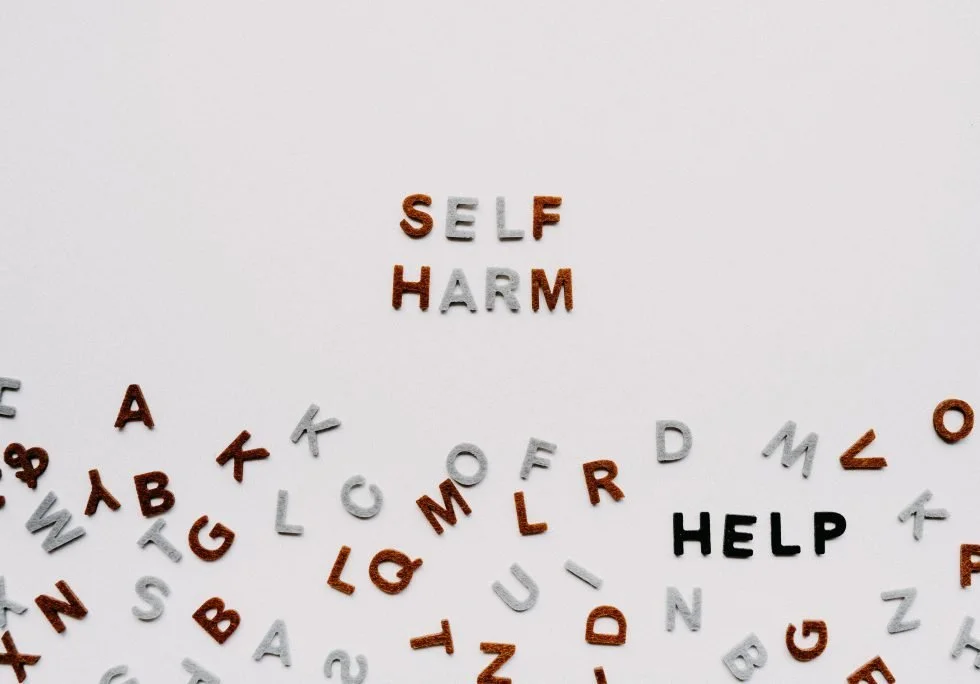Understanding Self-Harm
by Heather Hayes, M.Ed, LPC, CIP, of Heather Hayes & Associates
Self-harm is defined by the World Health Organization as “an act with non-fatal outcome, in which an individual deliberately initiates a non-habitual behaviour that, without intervention from others, will cause self-harm, or deliberately ingests a substance in excess of the prescribed or generally recognised therapeutic dosage” [1]. It is surprisingly common, yet many people know little about it. Statistics show varying degrees of prevalence; some researchers estimate that 5.9% of American adults have engaged in self harm at some point[2], while others claim that the figure is closer to 7.3%[3]. It is shown that the population outside of psychiatric institutions with the highest incidence of this are teenagers, with an estimated 15-20% engaging in self-harm at some point[4]. Even if the lowest statistic is used as a baseline, this issue still directly affects millions of Americans.
Researchers commonly use two acronyms to refer to self-harm: Non-Suicidal Self Injury (NSSI) and Deliberate Self Harm (DSH). For the purposes of this article, I will refer to all of these as “self-harm.” Self-harm is typically thought of as cutting oneself, which is indeed the most popular method, with 46% practicing this, but it can include using blunt force, like banging one’s head against an object, or burning oneself, among other actions[5].
Self-harm incidents can range from minor to life-threatening injuries, but all are especially dangerous because self-harmers are less likely to seek medical assistance[6]. It is absolutely crucial for practitioners to be aware that not all self-harm is visible. I once had a client who overdosed on Advil to self-harm through stomach pain. This would have remained untreated had I not carried out a comprehensive diagnostic interview with the client. It is also important to note that many clients do not consider what they are doing to be self-harm. This means that in order to thoroughly screen a client, practitioners must use targeted and comprehensive questioning.
Like many self-destructive habits, there is not one sole cause for self-harm. It is attributed to a multitude of factors, several of which may simultaneously come into play. Two studies have shown that rates of self-harm were much higher in teenagers who reported being bullied[7][8]. People have also reported self-harming to distract themselves or express feelings of loneliness, to release anger, to punish oneself, to feel in control of a situation, or to detach emotionally[9]. Often, trauma survivors either use self-harm as a way to re-channel the emotional pain into physical pain, giving them temporary relief and a way of physical expression, or may use cutting or self-harm to feel alive when they are feeling numb and dissociated[10]. Suicidal ideation is also a predictor for self-harm, and vice versa [11]. Childhood trauma has also been linked to self-harm[12]. Furthermore, increased risk of self-harm is associated with depression and anxiety[13], schizophrenia[14], and psychosis[15].
There is a variance among genders in how, how often, and why self-harm is committed; between men and women, it is shown that women are more likely to cut whereas men are more likely to burn or hit themselves. It has been postulated that this could be due to women feeling less like they have a “voice” in society and consequently expressing their feelings through harm[16] and it being more socially acceptable for men to express themselves through outward violence[17]. People who identify as transgender have an even higher rate of self-harm than those who identify as cisgender male or female; research has found that between 13-45% of transgender individuals between the ages of 16-20 engage in self-harm[18].
Due to its wide range of causes, there are many proposed treatments for self-harm. Usually, doctors and mental health specialists attempt to diagnose the underlying mental health condition which is precipitating the symptoms. Once the underlying source is identified, the condition can be treated with therapy and the drugs one would typically prescribe for such a disorder, e.g., SSRIs for depression or antipsychotics for schizophrenia.
Various therapeutic approaches have also been effective in treating self-harm, and it is suggested that these should be combined with pharmaceutical interventions. Group therapy has been shown to reduce instances of self-harm; however, it is important to note that this study did not find a reduction in depression[19]. Dialectical Behavioral Therapy has also been proposed to reduce self-harm and suicidal ideation[20]. Cognitive Behavioral Therapy is also commonly used and has been shown to be effective[21].
While it can be very hard to remove all potentially harmful items from a household or institution, steps can be taken to make it harder. Toxic household chemicals and sharp objects such as knives and razors should be stored in locked containers. If possible, internet access should also be restricted due to the worrying trend of pro-self-harm websites and Instagram tags that have been linked to an increase in self-harm[22] [23]. Restricting internet access should be approached as gently as possible, and there are many support groups available which some people have reported as helpful[24].
A study of teenagers who had histories of violent behavior towards themselves or others showed that mindfulness reduced both types of violence[25]. This practice has also been linked to a reduction in depression, anxiety, and psychosis, which are all predictors for self-harm[26]. Exercise and yoga have also been linked to a decrease in symptoms in some of these disorders[27]. However, there is little research on its direct effect on self-harm. Some specialists have also suggested punching or screaming into a pillow as a safe way of relieving stress.
In some instances, it may be safest to deliver treatment for self-harm and its associated disorders in a residential treatment setting. This has many benefits. For example, the client can be treated by trained professionals, and a personalized treatment plan can be administered in a safe and supportive environment.
Sources
[1] National Collaborating Centre for Mental Health (UK). Self-Harm: The Short-Term Physical and Psychological Management and Secondary Prevention of Self-Harm in Primary and Secondary Care. Leicester (UK): British Psychological Society; 2004. (NICE Clinical Guidelines, No. 16.2, Introduction to self-harm. Available from: https://www.ncbi.nlm.nih.gov/books/NBK56398
[2] Klonsky ED: Non-suicidal self-injury in United States adults: Prevalence, sociodemographics, topography and functions. Psychol Med. 2011, Pub: doi:10.1017/S0033291710002497
[3] Taliaferro LA, Muehlenkamp JJ, Borowsky IW, McMorris BJ, Kugler KC: Risk factors, protective factors, and co-occurring health-risk behaviors distinguishing self-harm groups: A population-based sample of adolescents. Acad Pediatrics.
[4] Klonsky, E David et al. “Nonsuicidal self-injury: what we know, and what we need to know.” Canadian journal of psychiatry. Revue canadienne de psychiatrie vol. 59,11 (2014): 565-8. doi:10.1177/070674371405901101
[5] Laye-Gindhu, Aviva, and Kimberly A. Schonert-Reichl. “Nonsuicidal Self-Harm Among Community Adolescents: Understanding The “Whats” And “Whys” Of Self-Harm”. Journal Of Youth And Adolescence, vol 34, no. 5, 2005, pp. 447-457. Springer Science And Business Media LLC, doi:10.1007/s10964-005-7262-z. Accessed 19 Aug 2020.
[6] Whitlock, Janis et al. “Nonsuicidal Self-Injury In A College Population: General Trends And Sex Differences”. Journal Of American College Health, vol 59, no. 8, 2011, pp. 691-698. Informa UK Limited, doi:10.1080/07448481.2010.529626. Accessed 19 Aug 2020.
[7] Claes, L., Luyckx, K., Baetens, I. et al. Bullying and Victimization, Depressive Mood, and Non-Suicidal Self-Injury in Adolescents: The Moderating Role of Parental Support. J Child Fam Stud 24, 3363–3371 (2015). https://doi.org/10.1007/s10826-015-0138-2
[8] Giletta M, Prinstein MJ, Abela JR, Gibb BE, Barrocas AL, Hankin BL. Trajectories of suicide ideation and nonsuicidal self-injury among adolescents in mainland China: Peer predictors, joint development, and risk for suicide attempts. J Consult Clin Psychol. 2015;83(2):265-279. doi:10.1037/a0038652
[9] Osuch, E. A., Noll, J. G., and Putnam, F. W. (1999). The motivations for self-injury in psychiatric inpatients. Psychiatry Interpers. Biol. Processes 62(4): 334–346.
[10] Nixon, M. K., Cloutier, P. F., and Aggarwal, S. (2002). Affect regulation and addictive aspects of repetitive self-injury in hospitalized adolescents. J. Am. Acad. Child Adolesc. Psychiatry 41(11): 1333– 1341.
[11] Beckman, K., et al. “Mental Illness and Suicide after Self-Harm among Young Adults: Long-Term Follow-up of Self-Harm Patients, Admitted to Hospital Care, in a National Cohort.” Psychological Medicine, vol. 46, no. 16, 2016, pp. 3397–3405., doi:10.1017/S0033291716002282.
[12] Low, Gail et al. “Childhood Trauma, Dissociation And Self-Harming Behaviour: A Pilot Study”. British Journal Of Medical Psychology, vol 73, no. 2, 2000, pp. 269-278. Wiley, doi:10.1348/000711200160363. Accessed 19 Aug 2020.
[13] O’Connor, Rory C. et al. “Predicting Depression, Anxiety And Self-Harm In Adolescents: The Role Of Perfectionism And Acute Life Stress”. Behaviour Research And Therapy, vol 48, no. 1, 2010, pp. 52-59. Elsevier BV, doi:10.1016/j.brat.2009.09.008. Accessed 19 Aug 2020.
[14] Catherine S. Symonds, Steve Taylor, Val Tippins, Douglas Turkington, (2006). Violent Self-Harm in Schizophrenia. Suicide and Life-Threatening Behavior: Vol. 36, No. 1, pp. 44-49.
[15] Challis, S. et al. “Systematic Meta-Analysis Of The Risk Factors For Deliberate Self-Harm Before And After Treatment For First-Episode Psychosis”. Acta Psychiatrica Scandinavica, vol 127, no. 6, 2013, pp. 442-454. Wiley, doi:10.1111/acps.12074. Accessed 19 Aug 2020.
[16] Cross, L. W. (1993). Body and self in feminine development: Implications for eating disorders and self-mutilation. Bull. Menninger Clin. 57(1): 40–68
[17] Taylor, B. (2003). Exploring the perspectives of men who self-harm. Learn. Health Soc. Care 2(2): 83–91.
[18] Liu, Richard T., and Brian Mustanski. “Suicidal Ideation And Self-Harm In Lesbian, Gay, Bisexual, And Transgender Youth”. American Journal Of Preventive Medicine, vol 42, no. 3, 2012, pp. 221-228. Elsevier BV, doi:10.1016/j.amepre.2011.10.023. Accessed 2 Oct 2020.
[19] WOOD, ALISON et al. “Randomized Trial Of Group Therapy For Repeated Deliberate Self-Harm In Adolescents”. Journal Of The American Academy Of Child & Adolescent Psychiatry, vol 40, no. 11, 2001, pp. 1246-1253. Elsevier BV, doi:10.1097/00004583-200111000-00003. Accessed 19 Aug 2020.
[20] Mehlum, Lars et al. “Dialectical Behavior Therapy For Adolescents With Repeated Suicidal And Self-Harming Behavior: A Randomized Trial”. Journal Of The American Academy Of Child & Adolescent Psychiatry, vol 53, no. 10, 2014, pp. 1082-1091. Elsevier BV, doi:10.1016/j.jaac.2014.07.003. Accessed 19 Aug 2020.
[21] Slee, Nadja et al. “Cognitive-Behavioral Therapy For Deliberate Self-Harm”. Crisis, vol 28, no. 4, 2007, pp. 175-182. Hogrefe Publishing Group, doi:10.1027/0227-5910.28.4.175. Accessed 19 Aug 2020.
[22] Harris, Isobel Marion, and Lesley Martine Roberts. “Exploring The Use And Effects Of Deliberate Self-Harm Websites: An Internet-Based Study”. Journal Of Medical Internet Research, vol 15, no. 12, 2013, p. e285. JMIR Publications Inc., doi:10.2196/jmir.2802. Accessed 19 Aug 2020.
[23] Mitchell, Kimberly J. et al. “Exposure To Websites That Encourage Self-Harm And Suicide: Prevalence Rates And Association With Actual Thoughts Of Self-Harm And Thoughts Of Suicide In The United States”. Journal Of Adolescence, vol 37, no. 8, 2014, pp. 1335-1344. Elsevier BV, doi:10.1016/j.adolescence.2014.09.011. Accessed 19 Aug 2020.
[24] Murray, Craig D., and Jezz Fox. “Do Internet Self-Harm Discussion Groups Alleviate Or Exacerbate Self-Harming Behaviour?”. Australian E-Journal For The Advancement Of Mental Health, vol 5, no. 3, 2006, pp. 225-233. Informa UK Limited, doi:10.5172/jamh.5.3.225. Accessed 19 Aug 2020.
[25] Yusainy, Cleoputri, and Claire Lawrence. “Relating Mindfulness And Self-Control To Harm To The Self And To Others”. Personality And Individual Differences, vol 64, 2014, pp. 78-83. Elsevier BV, doi:10.1016/j.paid.2014.02.015. Accessed 19 Aug 2020.
[26] Ivanovski, Belinda, and Gin S. Malhi. “The Psychological And Neurophysiological Concomitants Of Mindfulness Forms Of Meditation”. Acta Neuropsychiatrica, vol 19, no. 2, 2007, pp. 76-91. Cambridge University Press (CUP), doi:10.1111/j.1601-5215.2007.00175.x. Accessed 19 Aug 2020.
[27] Narinder Panesar & Iveta Valachova (2011) Yoga and mental health, Australasian Psychiatry, 19:6, 538-539, DOI: 10.3109/10398562.2011.620613
For questions or concerns contact TCA, or Hire a Therapeutic Consultant.

